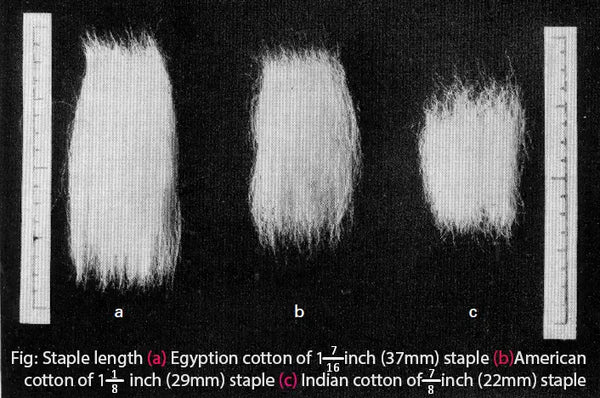Types of Cotton Fabric: The Quick Guide
Sep 14, 2023
Learn about the differences between cotton staple lengths, fiber processing techniques, and more!

Table of Contents
- Short Staple Cotton vs. Long Staple Cotton
- What is Ringspun Cotton?
- What is Combed Ringspun Cotton?
- What is a Loopwheel Cotton T-Shirt?
- The Secret of Loopwheel Manufacturing
What is short staple and long staple cotton?
-
Longer vs. shorter cotton fibers
-
Differences in strength and feel
The term “staple” refers to the length of cotton plant fibers used to weave a piece of cotton fabric. Shorter cotton fibers (“short staple”) are quicker to grow and therefore cheaper to produce and sell. When short staple cotton fibers are used to make cotton fabric, it ends up being rougher, stiffer, and less durable. Since the fibers are shorter, more of the ends of the fibers are exposed on the surface of the fabric, giving it that gritty texture and (depending on the blend) making it pill and shed more easily.
On the other hand, weaving cotton fabric with longer cotton fibers (“long staple”) results in a softer, smoother, and more durable fabric. The long fibers leave fewer fiber ends exposed when woven, therefore creating less texture and a fabric that feels higher quality/smoother/silkier. While long staple cotton seems like the superior choice, some people actually like the rough texture that short staple cotton provides. It’s all about your preference!

Source: Textile Study Center

Source: Wove Towels
What is Ringspun Cotton?
-
Woven cotton strands for smoother, stronger cotton
-
Usually more expensive than regular cotton
-
Can be combed or uncombed
Ringspun cotton yarn should be compared to open-end cotton yarn. The best way to picture the difference is that open-end yarn is essentially made like cotton candy, spun very fast and then pulled out of the machine that’s spinning. Ringspun cotton yarn on the other hand is more akin to selecting better fibers of cotton and twisting them together. Put simply: Ringspun cotton is cotton that is processed to soften, straighten, and remove short and medium staple cotton fibers from the cotton used to weave the fabric.

Source: Grailed
What is Combed Ringspun Cotton?
“Combing” removes even more short and medium staple fibers than just ringspun processing alone, so the fabric is left even smoother and stronger. It quite literally entails further processing of the cotton by combing it finely to remove any impurities or foreign substances before it is spun.
What is a loopwheel cotton t-shirt?
-
A cotton fabric weaving technique
-
Very traditional, time consuming, and expensive
If you’re interested in fashion, you may have heard the term “loopwheel cotton” and wondered what it meant. The defining feature of a loopwheel t-shirt is that it’s made on vintage loopwheel knitting machines. The shirts most often also have no side seams.*
A true loopwheel cotton shirt is made in one of about 5 factories in the world, and it is very time consuming. Vintage tubular knitting machines are used where there is almost no tension applied to the fabric when it’s being woven. These machines can only make one size of t-shirt, meaning if a factory were to produce multiple sizes, they would need separate machines for each.

Source: Okayama Denim
What’s the benefit of a loopwheel cotton t-shirt?
Loopwheel cotton shirts are stronger, last longer, and maintain their shape better than other types of woven t-shirts. Although, there isn’t a lot of specific data around these benefits, so we don’t know exactly how much better these shirts hold their shape, or how much more durable they are. What we do know is that true loopwheel cotton manufacturers always use the highest quality cotton and carefully consider the fit and any additional details that elevate the structure, comfort,and durability of these shirts.

The bottom line? Manufacturers who make loopwheel t-shirts don’t skimp on quality.
The Secret About Loopwheel T-Shirts
While there are only a few true loopwheel factories in the world, a lot of brands claim they also make ‘loopwheel cotton shirts’ by bending the definition of “loopwheel”. Some use the term to refer to any tubular knit t-shirt, while other companies use a more modern version of the vintage, classic loopwheel machines. Some use the same type of needle (a ‘bearded’ needle) as a traditional loopwheel machine, or use a similarly slow weaving process and claim that it is “loopwheel”.

To confuse things more, some alleged “loopwheel” t-shirts do actually have side seams. This happens when the manufacturer doesn’t actually have the different machines for the different sizes, so they cut and stitch together pieces of loopwheeled cotton fabric to make a larger size.
So, it basically depends on who you are talking to and how the company defines their loopwheel shirt. What we can say with confidence is that if the company is one of the true loopwheel manufacturers that uses vintage machines and takes no shortcuts, they will make it clear to customers.
The Takeaway
-
Cotton fiber length matters in strength and softness of the fabric
-
Cotton processing like “ringspun” affect cotton fabric quality
-
Traditional techniques for weaving cotton t-shirts (e.g. “loopwheel”) are rare and result in some of the best quality cotton t-shirts on the market

The Iron Snail is a men’s fashion vlog starring a young man named Michael and featuring a snail no bigger than a quarter. The two are set on taking over the world of fashion by creating a clothing line to end all clothing lines. Until then, we’re here to tell you EVERYTHING you need to know about the best clothing out there, from the highest quality raw denim jeans to the warmest jacket to the sturdiest boots…the Iron Snail has got you covered.
Taylor Hale is your friendly neighborhood tea enthusiast, amateur knitter, skincare nerd, clothing thrifter, regular flosser, accidental teapot collector, vintage ikea lamp hunter, overzealous plant owner, beeswax candle-lover, gal pal, and obviously, very serious academic. She writes for the Iron Snail, as you can see.


